#librarypreservation
Text
Preserving Leaf Paintings in an Anglo-Indian Commonplace Book, 1822-1825
Hello, I’m Alexa Machnik, a third-year graduate student at the Conservation Center, Institute of Fine Arts, NYU. I first came to the Barbara Goldsmith Preservation & Conservation Department in Fall 2022 as a student in the graduate course, Conservation in Context, taught by Laura McCann, Director of Preservation. During this course, we delved into the world of library conservation, exploring the value systems that guide preservation decision-making and treatment action in academic research libraries. One of my class projects involved rehousing delicate leaf paintings from an early 19th-century commonplace book, or friendship album, part of the Fales Library holdings in the Special Collections at NYU Libraries (figs. 1-2) [1]. In honor of Preservation Week, I will share the intriguing history of the book and discuss the decisions that were made to preserve the leaves.

Figure 1 [left]: Front cover of the commonplace book, bound in gold-tooled red morocco leather.
Figure 2 [right]: Ownership label of “Jane Harriet [Blechynden]” on front marbled pastedown.
The book in question was compiled by Jane Harriet Blechynden (1806-1827) in England between 1822 and 1825. It holds her personal collection of handwritten and acquired materials, with contributions from her sisters, Emma and Sarah, who wrote original poems about sisterhood, separation, and their Anglo-Indian ancestry. The three women were the daughters of a British merchant residing in Calcutta, and while born in India, they were educated in England [2]. There is not a great deal known about Jane Harriet’s life in England, but her impending return to India in 1825 is documented in an emotional verse by Emma (fig. 3):
“Thus in parting my sister we’re breaking a link / Which may ne’er be united again / And firm as that chain was ‘tis painful to think / That absence may send it twain.”

Figure 3: Excerpt from the original poem, “Parting and a Meeting,” signed by Emma.
Jane Harriet’s book offers insights into her personhood, social connections, and sensibilities as an artist and collector. In addition to written entries, she inserted a compendium of acquired materials–pressed flowers, her own original drawings, and numerous paintings–between pages of the book (figs. 4-6).

Figures 4-6 [left to right]: A small sampling of the ephemeral treasures found in the book, including a dried pressed flower, a drawing on pith possibly by Jane Harriet, and a cut-paper silhouette.
Notably, six of these paintings are executed on the dried leaves of the Bodhi tree, a sacred plant indigenous to Asia with distinct spade-shaped, long-tipped leaves (fig. 7) [3]. Although leaf painting has origins in Buddhist traditions, by the time Jane Harriet collected her leaf paintings, it had already evolved into a form of Chinese export art in Europe. Her leaves depict secular scenes of contemporary life in China and botanical subjects, which are typical of the export genre (fig. 8). Their inclusion in the book implies that Jane was among the many people who partook in the avid collecting of China trade goods during the first few decades of the 19th century, a time when European fascination for Chinese culture and art was at its peak.

Figure 7: A leaf painting, as found loose in the book and partially lifted to show the thin, translucent nature of the leaf support.

Figure 8: Another leaf painting from the book, oriented with the leaf tip at the bottom of the image, depicting flowers and a butterfly.
The initial rush of excitement that I felt at finding the leaf paintings soon turned to concern as I gave thought to their long-term preservation at NYU Libraries, where researchers are expected to handle the book. The leaf paintings were loose in between the pages, which raised a series of “what ifs” about the potential dangers they could encounter. What if the leaves slip from the book? What if they bend or break as the pages are turned? What if the painted surfaces become abraded? The paintings were made with opaque pigment-based watercolors on exceptionally delicate, skeletonized leaves that have been primed with a thin organic coating. Despite being intact, their inherent fragility means that they are vulnerable to even the slightest touch. After considerable discussion, the Conservation Unit decided that in order for the leaf paintings to be preserved and safely accessed by researchers, they should be housed separately from the book.
I thoroughly examined the condition of the leaves and the painted surfaces in order to make a housing recommendation. Despite some minor damage, all were in stable condition. Thus, the ideal housing would provide support to prevent any further damage, such as paint loss and leaf breakage, and at the same time allow the leaves to maintain their translucency. To achieve this, I opted to mount them in double-sided window mats with a support made from clear polyester film, or Mylar® [4]. The addition of the Mylar® would not only create a stable surface for the leaf paintings but also enable the viewing of both sides (fig. 9).
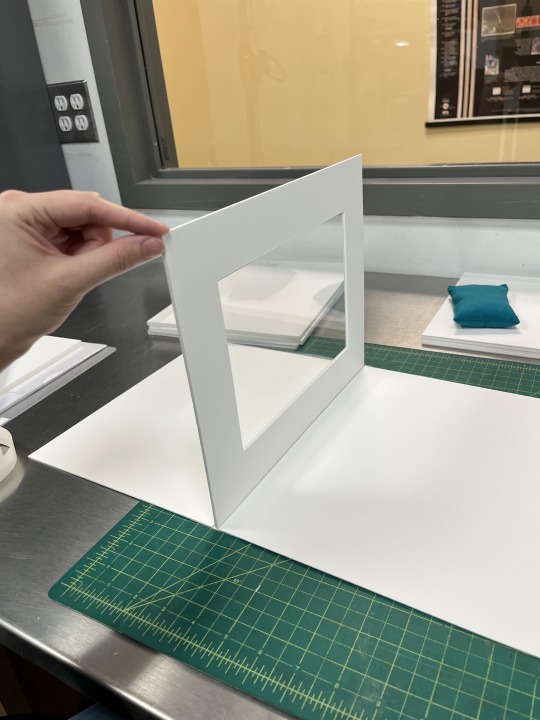
Figure 9: View of the double-sided window mat with a Mylar® support.
My next challenge was to figure out how to mount the leaves onto the Mylar® support without the use of adhesive [5]. After consulting with conservation staff and creating mock-ups, short, discreet Mylar® tabs were selected as the best option to secure them into place (figs. 10-11). For this process, I positioned a single leaf painting onto the support and selectively placed the tabs around its perimeter, making sure the tabs did not overlap any areas of paint. I then used a handheld spot-welding pen to fuse the tabs to the support. Since this process was done in-situ, near the leaf, it required lots of precision practice and encouragement from colleagues before I felt confident enough for the task.

Figure 10: Detail of a mounted leaf painting. Notice that the Mylar® tabs are welded just outside the leaf and extend minimally over the edges, holding it in place with gentle pressure.

Figure 11: The backside of a mounted leaf painting viewed through the Mylar® support. This gives researchers access to the painting’s verso, where an underdrawing and other signs of artistic process can be discerned.
At the time of writing this post, I successfully housed the six leaf paintings in their double-sided window mats (figs. 12-13). This housing project, while complete, is just one part of the ongoing effort to preserve the commonplace book, and the Conservation Unit is continuing work on other elements of the book to ensure its safe return to Special Collections.
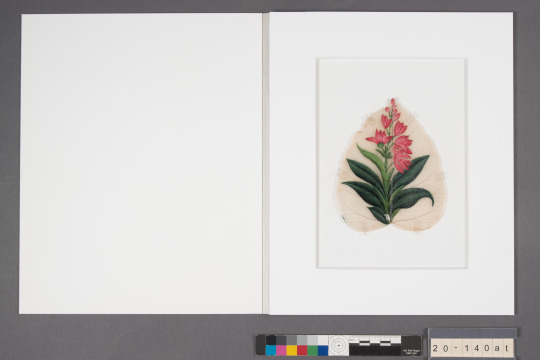
Figure 12: Example of the completed housing, showing the front of a leaf painting.

Figure 13: Back of a leaf painting.
Though my involvement in the project has come to an end, I have gained a very special appreciation for the commonplace book and the preservation challenges it presents. The experience of learning directly from NYU Libraries Special Collections was especially invaluable, providing me with opportunities to participate in complex decision-making processes unique to large research libraries driven by user needs. Before signing off, I’d like to extend my gratitude to my supervisors, Laura McCann, Director, and Lindsey Tyne, Conservation Librarian, and the entire team at the Barbara Goldsmith Conservation Lab for their unwavering support and enthusiasm throughout this project. Thank you all very much!
Notes:
[1] A commonplace book is a centralized place for an individual to record information, whether it be their personal thoughts or quotes from outside literary sources. Friendship albums, by contrast, contain handwritten entries from the family, friends, or acquaintances of the owner (often female). Both forms of commonplacing sustained popularity in Europe and America throughout the 19th century. To learn more about this fascinating literary genre, see Jenifer Blouin, “Eternal Perspectives in Nineteenth-Century Friendship Albums,” The Hilltop Review, Vol. 9, Issue 1 (2016) and Victoria E. Burke, “Recent Studies in Commonplace Books,” English Literary Renaissance, Vol. 43, No. 1 (2013), 153-177.
[2] Much of what is known about Jane Harriet (also known in her family as Harriet) comes from the Blechynden papers in the British Library (Add. Mss. 45578-663). This large holding contains the diaries of her father, Richard (Add. Mss. 45581-653), and older brother, Arthur (Add. Mss. 45654-61). For a secondary account of the Blechynden household, see Peter Robb, Sentiment and Self: Richard Blechynden’s Calcutta Diaries, 1791-1822 (New Delhi: Oxford University Press, 2011).
[3] Michele Matteini, “Written on a Bodhi tree leaf,” Anthropology and Aesthetics, Vol. 75-76 (2021), 45-58.
[4] The design of the double-sided mats is based on an instructional guide made available by the Library of Congress. “Double-Sided Mat,” Library of Congress, accessed 1 February 2023.
[5] We chose not to use adhesives or traditional paper-hinging techniques to mount the leaf paintings for several reasons. As noted, the paintings are on fragile, non-paper-based supports that have an organic coating, which may be derived from plant gum. The leaf supports are thin, translucent, and highly vulnerable to breakage, so applying hinges directly with adhesive might permanently alter their appearance or risk further damage to the leaves over time, especially if they need to be removed from the housing in the future.
Photographs: Alexa Machnik
#NYULibraries#NYUSpecialCollections#FalesLibrary#nyuifa#nyuart#librarypreservation#libraryconservation#collectionscare#artconservation#paperconservation#bookconservation#artpreservation#preservingthepast#PreservationWeek#preservationweek2023
208 notes
·
View notes
Photo
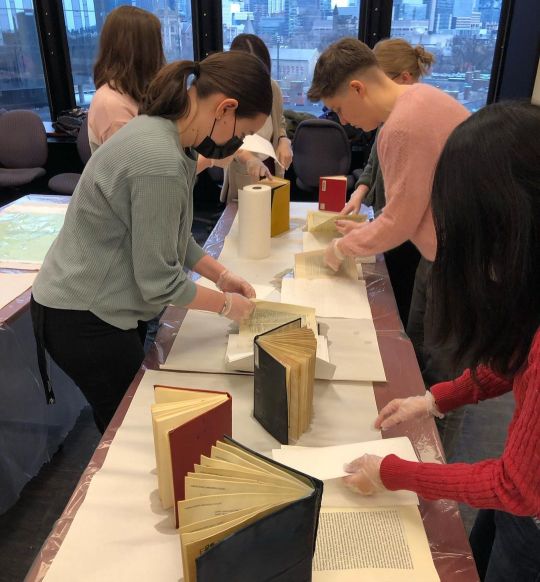
I had a great time today teaching for @ischool.learninghub. We saved a stack of books from the water disaster. I look forward to teaching book repair for them next month. #waterdisaster #librarypreservation #disasterresponse #bookconservation #bookpreservation (at Learning Hub, Faculty of Information, University of Toronto) https://www.instagram.com/p/CnuqNEPJnhU/?igshid=NGJjMDIxMWI=
7 notes
·
View notes
Video
youtube
Library Preservation at Harvard: This video really explains the value of collection preservation for teaching and research; a lot of other institutions have equally valuable resources, and they struggle along with a much smaller pool of resources (staffing, endowment$, visibility) than Harvard
#librarypreservation#preservationoutreach preservationeducation artconservation paperconservation bookconservation timebasedmedia
0 notes
Photo

Clamshell boxes aren’t only for books. This set of book week posters received a custom sized box with a little room to add some more over time. The clamshell box can be custom made to your needs and and to protect your collections. Join Andrew for his online class on how to make this great protective enclosure. See the details on the website, link in the bio. #clamshellbox #preservationenclosure #protectyourbooks #librarypreservation https://www.instagram.com/p/CE9ywVKpfXQ/?igshid=1akgzavnbl6hj
0 notes
Photo
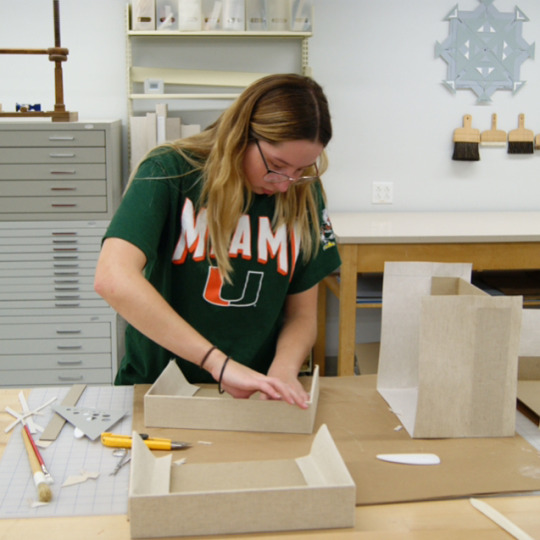
Our friends @nul_prescons reminded us that this is Preservation Week. We were happy they did since that means we get to feature the staff and students that work in our house lab to protect, mend, flatten, deacidify, clean, and monitor all of our storage areas. Our lab, currently staffed by Conservator Duvy Argandona relies on student workers to make many of our book enclosures. Freshman Rayne Mershon can be seen her measuring a trimming linen fabric for a box before applying PVA glue. We are constantly amazed (not to mention thankful!) at the skill displayed by Duvy and her students. #preswk #librarypreservation #libraryconservation #bookboxes #bookpreservation #specialcollections #librariesofinstagram #ig_libraries #iglibraries http://ift.tt/2q0LZnM
12 notes
·
View notes
Photo

We’d really love a fancy pants humidification dome, but we don’t have the space or the funds for something like that. A recent donation was delivered in large Rubbermaid bins. Once emptied and cleaned, I cut a hole in the side to make a port for the hose connected to our ultrasonic humidifier. I can pump in moist air, allowing rolled posters and documents to relax enough to be unrolled safely. It looks little funky, but it gets the job done! #equipmenthack #humidification #paperconservation #librarypreservation #specialcollections (at MSU Libraries)
23 notes
·
View notes
Text
Preservation Week 2023
Virtual Presentation: Conservation of Balinese Shadow Puppets from the Mabou Mines Archives
Date: Tuesday, May 2, 2023, 1:00 - 2:00 PM (EST)
Location: Virtual Event/Zoom
Registration: https://nyu_preservation_week_2023.eventbrite.com
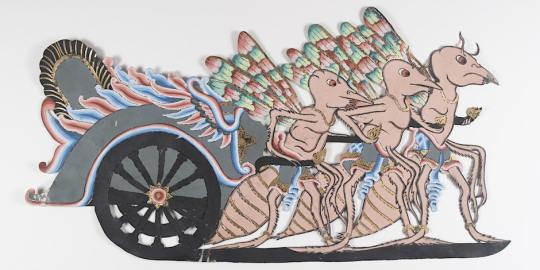
Image: a Balinese shadow puppet from the Mabou Mines Archive, NYU Special Collections.
Since last November, Conservation Center student Peiyuan Sun has been conducting research and conservation treatment on a group of Balinese shadow puppets from the Mabou Mines Archive (MSS.133). In this presentation, she will talk about the information that she has discovered regarding the history and manufacture of these materials and the ways in which she is actively working to make these items more accessible to future users.
Peiyuan Sun received her B.A. in Art History from NYU in 2018. She is in her final year at NYU’s Institute of Fine Arts, where she is a candidate for an M.A. in Art History and M.S. in Conservation of Historic and Artistic Works. Since fall 2022, Peiyuan has been working as an Andrew Mellon Fellow at the Barbara Goldsmith Preservation and Conservation Department for her curriculum internship under the supervision of Preventive Conservator Jessica Pace.
This event is presented in celebration of Preservation Week, an annual initiative of the American Library Association aimed at connecting our communities through events, activities, and resources that highlight what we can do, individually and together, to preserve our personal and shared collections.
#PreservationWeek2023#PreservationWeek#NYULibraries#NYUSpecialCollections#FalesLibrary#nyuifa#nyuart#librarypreservation#libraryconservation#collectionscare#artconservation#artpreservation#preservingthepast
26 notes
·
View notes
Text
Preservation Week 2024
Virtual Presentation
Go Violets!: The History & Conservation of NYU’s Yearbook Collection
Date & Time: Wednesday, May 1, 2024 · 11 AM - 11:45 AM EDT
Location: Virtual
RSVP: eventbrite
Event Series: NYU Libraries Preservation Week 2024

In celebration of Preservation Week 2024, the Barbara Goldsmith Preservation & Conservation Department is hosting a virtual presentation exploring NYU Libraries’ extensive yearbook collection. The collection contains almost 1000 yearbooks dating from 1887 to 2012 issued by New York University and its component schools. It is one of the most heavily used collections in the New York University Archives. University Archivist Janet Bunde will discuss the history and use of the collection, and Special Collections Conservator Dawn Mankowski will discuss conservation treatment and her recent survey of the collection that will be used to guide our preservation priorities and ensure continued access to this important record of NYU history.
Collection Information:
https://findingaids.library.nyu.edu/archives/mc_304/
Janet Bunde (she/her) is the University Archivist in the Special Collections Department at NYU Libraries where she is dedicated to the stewardship and preservation of the collections. Janet holds a BA in history with a concentration in peace and conflict studies from Haverford College, and an MA in history with a certificate in archival administration from New York University.
Dawn Mankowski (she/her) is a Special Collections Conservator in the Barbara Goldsmith Preservation & Conservation Department at NYU Libraries where she cares for and carries out conservation treatment on NYU’s library and archival collections. Dawn holds a BA in Art History and Anthropology from the University of Arizona, and an MA in the Conservation of Art from SUNY Buffalo State College, specializing in Library and Archives Conservation.

#PreservationWeek2024#PreservationWeek#NYULibraries#NYUSpecialCollections#librarypreservation#libraryconservation#collectionscare#paperconservation#bookconservation#preservingthepast
2 notes
·
View notes
Photo
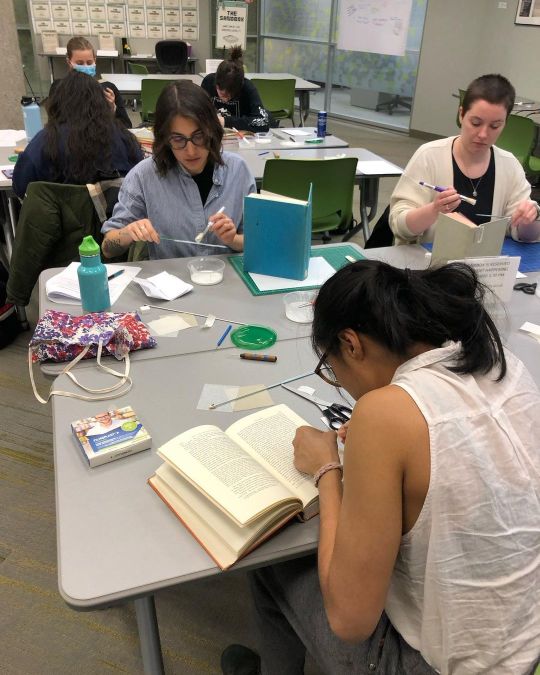
I taught a fun workshop at the @ischool.learninghub yesterday on basic book repairs. The students did a great job and I hope their home book collections will be back in shape by Monday. #bookrepair #librarypreservation #loosehinges #paperrepair #bookconservation (at Learning Hub, Faculty of Information, University of Toronto) https://www.instagram.com/p/CoNFm5Lur0P/?igshid=NGJjMDIxMWI=
6 notes
·
View notes
Photo

Today I gave the TA at @ischool.learninghub a heart attack when I threw books into tubs of water for our emergency response and recovery workshop this weekend. Let’s hope I don’t make any of the students cry. We’ll save all the books we can. #bookconservation #bookrecovery #disasterresponse #librarypreservation #savethebooks (at Learning Hub, Faculty of Information, University of Toronto) https://www.instagram.com/p/Cnp7Qo0r7vd/?igshid=NGJjMDIxMWI=
2 notes
·
View notes
Photo
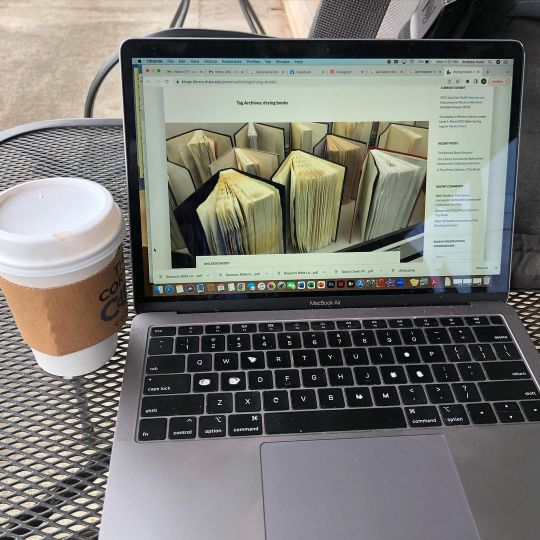
I’m reviewing resources and articles for my upcoming Disaster Response Techniques workshop for @ischool_to . We’ll be getting our hands wet saving books and archives soon. #disastertraining #wetbookrecovery #bookconservation #librarypreservation #inpersonworkshop (at Toronto, Ontario) https://www.instagram.com/p/CnfJM41JGkz/?igshid=NGJjMDIxMWI=
3 notes
·
View notes
Photo
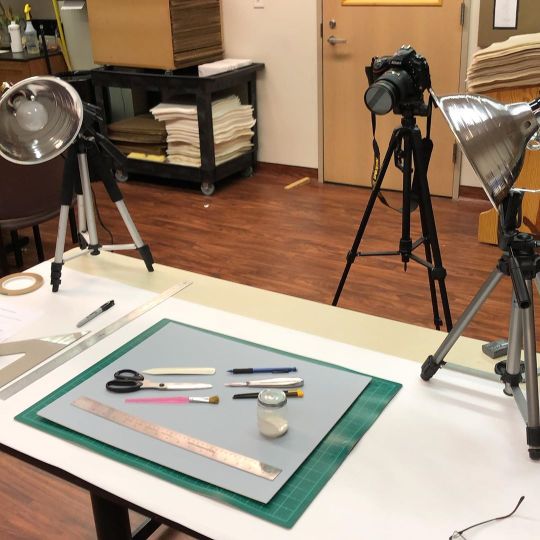
Preparing for the online lecture tonight at the @rcw_papermuseum on preservation of books and papers. We’re filming the process of making a corrugated clamshell box before the lecture gets under way. #librarypreservation #bookconservation #onlinelecture (at Robert C. Williams Paper Museum) https://www.instagram.com/p/CEXmczopzqh/?igshid=1vskq9kkt5z3l
7 notes
·
View notes
Photo
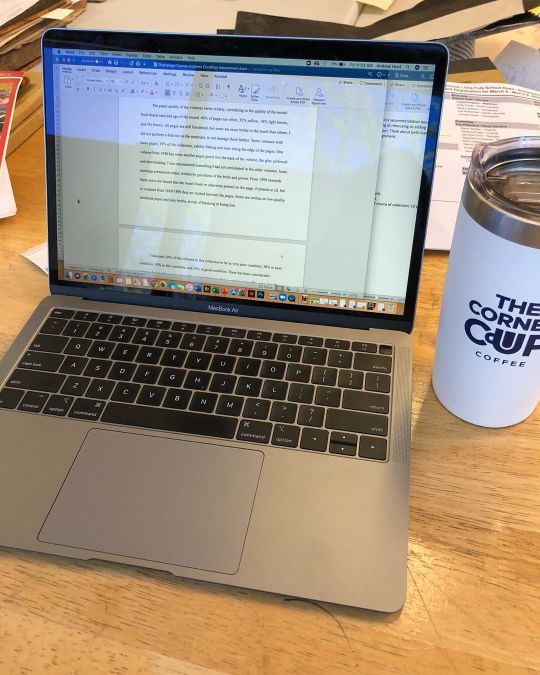
When we can’t get into the shop, we catch up on other things. Today Andrew is grading papers from his University of Illinois class on library preservation. Not as much fun as mending a book. #librarypreservation #conditionreports #studentprojects (at Big River Bindery) https://www.instagram.com/p/B-hiSAcJE0P/?igshid=ny86fqkgxge
1 note
·
View note
Photo

Had a great time with the staff of the preservation department at Indiana University in Bloomington this week. #Repost @hermanbwells ・・・ This week in the #CraigLab, we are learning about historic book structures from Andrew Huot of Big River Bindery in Atlanta. Today alone we made five models! One on alum-tawed thongs, one on double cords, one on single cords, one unsupported, and one recessed cords. Can’t wait to see what we do tomorrow! Understanding the way that books were made is important when it comes to repairing them! #LibraryPreservation (at Indiana University) https://www.instagram.com/p/B2ZbKMpntcu/?igshid=bcekwyi6yr9l
4 notes
·
View notes
Photo

There’s still time to sign up for Care and Repair of Book Collections at @preservationcenter in Freeport, IL. See more at www.preservationcenter.org #bookconservation #bookrepair #bookpreservation #librarypreservation (at International Preservation Studies Center) https://www.instagram.com/p/BpULCfug9Bz/?utm_source=ig_tumblr_share&igshid=y3bhn59jgkeq
3 notes
·
View notes
Photo

The clean classroom before we start our Boxes and Enclosures workshop at the Intl Preservation Studies Ctr. I'm looking forward to a productive week. @preservationcenter #boxmaking #librarypreservation #archivalboxes #bookbinding #bookconservation (at International Preservation Studies Center)
0 notes